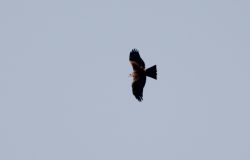September will be starting in a few days and for all those who love birdwatching in Malta, the coming weeks will bring with them a spectacle in the skies as the autumn migration slowly picks up. The stars of this spectacle are the raptors…in other words birds of prey, which have already started reaching our islands although it will take a couple of more weeks to reach the peak of the autumn migration. Notwithstanding this, a number of other birds can already be observed at this exciting time of year – such as herons, egrets, bee-eaters and smaller passerines.
It will probably be mid-September when we get the first thunderstorm and as the weather starts changing, raptors flying from Sicily will start landing on Malta. This will be the peak of season. Marsh Harriers (Bagħdan Aħmar) and Honey Buzzards (Kuċċarda) usually fly in in their hundreds, looking for a place to spend the night. The woodlands at Buskett and the valleys under Laferla Cross within the outskirts of Siġġiewi become the stage for one of the most spectacular wildlife performances in Malta, as flocks of these wonderful birds of prey gather in the sky, circling and converging over the area. Being the largest wooded area in Malta with a very high altitude, Buskett is the right place to be at this time of year to watch birds of prey. Here, daily observations are made by local birdwatchers to monitor the autumn raptor migration.
But how and why does autumn migration in Malta happen?
Every autumn many migrating birds crossing the Mediterranean Sea on their way to Africa seek shelter on the Maltese Islands after having spent their summer in Europe. Europe’s birds use three main routes to travel between their European breeding grounds and African wintering grounds – in the east over the Bosphorus, in the west over Gibraltar, and in the central Mediterranean via Italy, Sicily and Malta. This places Malta on one of the migration routes – better known as ‘flyways’ – for these majestic creatures crossing over between mainland Europe and Africa. Which makes September and October the best months to look out for these birds on migration in Malta.
The routes followed by migratory birds are numerous, and while some of them are simple and easily traced, others are extremely complicated. Differences in distance travelled, in time of starting, in speed of flight, in geographical position, in the latitude of the breeding and wintering grounds and in other factors all contribute to great diversity. Although bird migration is generally thought of as a north-and-south movement, no two species follow exactly the same path from beginning to end.
In so many words, Malta has an important role as an island on its own migration flyway and we should consider ourselves lucky that during the coming months we shall be able to witness the beauty of this phenomenon as birds such as Black Kites, Ospreys, Honey Buzzards, and Marsh Harriers together with some kestrels, falcons, vultures and eagles…but also others such as Bee-eaters and Hoopoes and the occasional Black Stork and White Stork, stop over Malta while travelling large distances from northern Europe to central Africa.
This is the magic of migration…a magical time that is for everyone to enjoy. If you have some free time, in particular at the highest points of the island, look up and keep your eyes focused so that even you witness the raptors on their journey to Africa. So let it all begin!
Read the Maltese version of the press release here.


